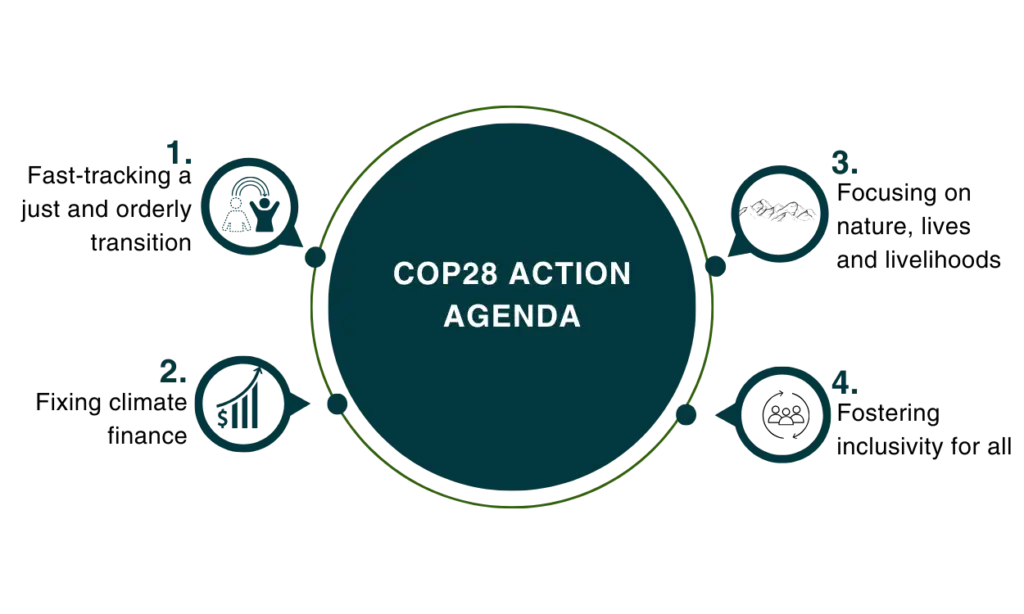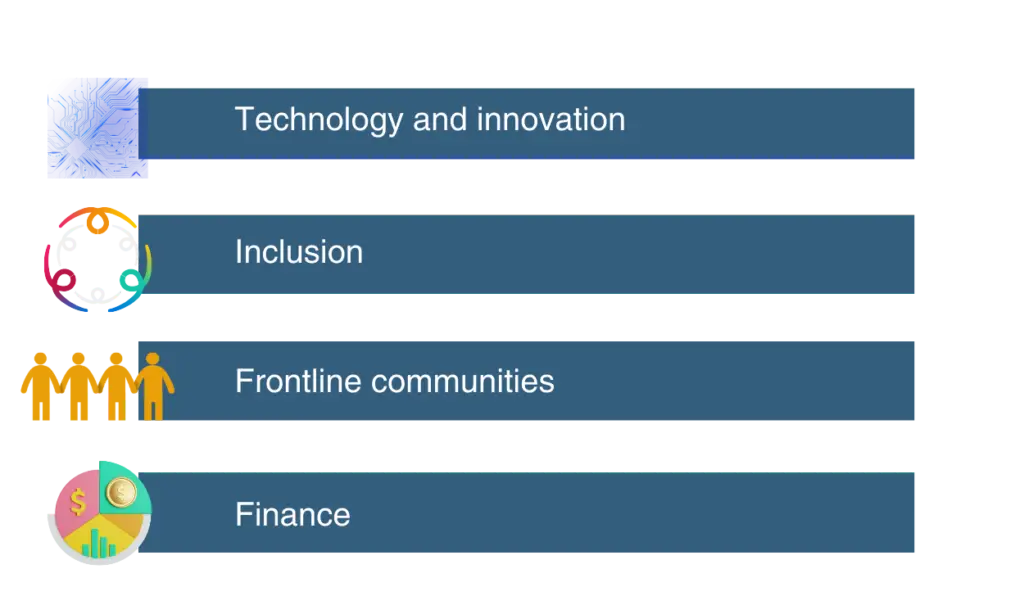 Kate Kyriakopoulou
Kate Kyriakopoulou

The COP28 in the United Arab Emirates (UAE) was expected to be a significant event that would assess global progress on the Paris Agreement. It lasted 13 days, starting on November 30 and ending on December 12, 2023, at Expo City, Dubai. This COP is considered one of the most inclusive COPs ever organised, with Blue and Green zones working side-by-side to deliver accurate, actionable solutions to address the climate crisis. The COP28 UAE President, who assisted the 198 parties in reaching a negotiated deal on climate change, was Dr. Sultan Al Jaber, who also acts as CEO of the Abu Dhabi National Oil Company. More than 70,000 delegates were expected to attend COP28.
And suppose you wonder why COP28 is crucial. In that case, the Nature Conservancy highlights that the globe is currently experiencing unprecedented consequences due to a warming planet, including unparalleled wildfires, catastrophic floods, and unbearable heatwaves. To make matters worse, the inaugural assessment of climate efforts, known as the Global Stocktake, highlights the significant gap between our current actions and climate goals. Urgent and concrete measures are imperative to address these challenges and safeguard the climate, and they are needed immediately. This is why COP28 is the world’s chance to level up. This conference was expected to drastically affect climate policies in the future, according to abcNEWS, as it is at the forefront of establishing ambitious policies on a global scale to facilitate the rapid mitigation of warming temperatures.
The 1992 United Nations Earth Summit in Rio established the UN Framework Convention on Climate Change (UNFCCC). Thus, a legal framework for combating climate change was provided for international cooperation. COP, which stands for “Conference of Parties,” represents high-level conferences that bring together states, regional organizations, and non-state actors, according to COP28’s official website. They are mega-events that attract tens of thousands of political leaders, businesspeople, sectoral experts, climate activists, and public members who work together on solutions to tackle climate change. There are currently 198 official parties, comprising 197 countries, in addition to the European Union. Any meeting of the parties can be officially considered a COP.
The milestone climate treaty of 2015, namely the Paris Agreement, is the COP’s responsibility. While everyone was waiting for the primary outcome of COP28, let us look at the main results of the last seven climate summits, as ALJAZEERA highlights.

Following the initial Conference of the Parties to the UN Framework Convention on Climate Change in 1995, let’s examine what COP28 is mostly about.
The main objective of COP28’s Action Agenda was to halt the climate crisis and keep 1.5C within reach, with the aim of fulfilling the objectives and aspirations of the Paris Agreement. To accomplish this, the Global Stocktake showed that a reduction of 22 gigatons of emissions before 2030 is required. The inaugural Global Stock Take (GST) aims to thoroughly assess advancements since adopting the Paris Agreement. Its purpose is to coordinate initiatives related to climate action and identify necessary measures to address any gaps in progress. COP28 is the first global stocktake on progress made for goals outlined in the Paris Agreement.
Therefore, the agenda was focused on the following four key areas, which are the four pillars of GST:

1. Moving quickly to a different energy source and cutting emissions before 2030 to keep global temperatures to 1.5°C (2.7°F) above pre-industrial levels.
2. Lay out the rules for a new financial deal. Developing countries must be able to pay, get access to, and use climate finance.
3. Put people, nature, their lives, and their ways of making a living at the center of climate action. This means helping the most vulnerable areas adjust to the changes that are already happening.
4. Call for the most inclusive COP ever, ensuring that Indigenous Peoples and local communities are involved in all decisions, discussions, and ways of putting the answers into action.
The 2-week schedule was the following:
| Days | Events |
| Nov 30 | Opening Day |
| Dec 1 | World Climate Action Summit |
| Dec 2 | World Climate Action Summit |
| Dec 3 | Health, Relief, Recovery and Peace |
| Dec 4 | Finance, Trade, Gender Equality and Accountability |
| Dec 5 | Energy and Industry, Just Transition and Indigenous Peoples |
| Dec 6 | Multilevel Action, Urbanization and Built Environment / Transport |
| Dec 7 | Rest |
| Dec 8 | Youth, Children, Education and Skills |
| Dec 9 | Nature, Land Use, and Oceans |
| Dec 10 | Food, Agriculture and Water |
| Dec 11–12 | Final Negotiations |
Each day of programming incorporated four cross-cutting themes that underpinned effective, interconnected delivery. These were:

The climate challenges that COP28 UAE addressed—to unlock climate opportunities—were the following, as we can discern on COP28’s official website:
As CNN highlights, negotiators at COP28 have discussed an agreement in which they could call for the phase-out of fossil fuels, which are the primary driver of climate change. More than 100 countries supported a phase-out in some form, but some oil-producing nations did not want any reference to reducing oil and gas at all. The United States was one of more than 120 countries that consented to tripling the world’s renewable energy capacity and doubling efforts to save energy. At the meeting, fifty large oil and gas companies, such as Exxon and Saudi Aramco, committed to reducing the amount of methane they release into the air by the end of the decade. They also concluded that flaring should cease by 2030.
The key outcome from COP28 Week 1 was adapting the new Loss and Damage Fund for climate victims. More specifically, on day one of COP28, the Presidency facilitated a historic agreement to operationalise and capitalise on funding for Loss and Damage, supporting people on the front lines of the climate crisis with $792 million pledged in total.
Concerning the consensus on fossil fuels, a deal draft released on Monday was criticised by many nations as weak for failing to call for a “phase-out” of fossil fuels, according to Reuters. Not only did the US and the EU, but also small island nations and more than 100 other countries, push for the word. However, oil producer group members fought strongly against it. The draft that came out on Monday listed eight ways that countries “could” cut emissions. One was “reducing both consumption and production of fossil fuels in a just, orderly, and equitable manner to achieve net zero by, before, or around 2050.”. Early Wednesday morning, a new draft text for the final deal came out.
Finally, today, Sultan Al Jaber, Cop28 president, announced the adoption of the global stocktake text at the final plenary. He declared that the delivered text is a robust action plan to keep 1.5 °C within reach, a plan that addresses emissions, and it is built on common ground while strengthened by total inclusivity. It is a historic package to accelerate climate action, as we can read in The Guardian.
Let’s look at the most crucial points that happened during COP28:
H.E. Razan Al Mubarak, the UN Climate Change High-Level Champion for COP28, declared that “there is no path to keeping 1.5°C within reach without protecting nature, land, and the ocean. We must unite behind nature positive solutions”.
Some additional facts that happened during the COP28, as we can discern in The National, are the following:
Following this year’s COP wrap, it will be interesting to closely observe how all the challenges will be tackled until the next one (COP29) which was announced to be held in Baku, Azerbaijan.
At EcoSkills, we stay tuned to the most recent news and developments around climate change to identify what is being done worldwide for its mitigation and adaptation. Follow us and stay skilled and updated through our certified course on Climate Change and Business Resilience.
